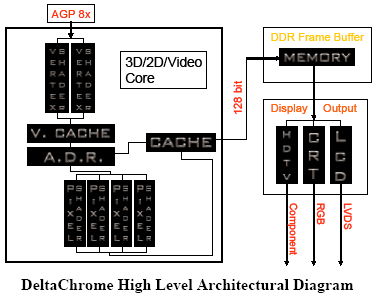S3's DeltaChrome S4 Pro
The Drivers & Architecture

|
When we were first exposed to S3's DeltaChrome drivers earlier this year, we felt that their software engineers still had some work to do with regard to the interface and overall look of the driver panels. A few months have passed since our initial look at S3's DeltaChrome drivers, but not much has changed on the surface...
The overall look of the DeltaChrome's driver suite still looks somewhat dated to us and is in need of a major overhaul. The functionality is there, and the drivers were stable, but the interface just doesn't seem nearly as refined as NVIDIA's Forceware or ATi's Catalyst driver suites. The bright colors and dated generic icons should be replaced, and the brushed metal backgrounds just don't mesh well with Windows XP. The individual driver panels should be more symmetrical, and the cascading dialog boxes create an unbalanced look. These are relatively minor issues in the grand scheme of things, however, as the drivers give users a lot of control over the hardware, and all of the options we tested functioned as they should.
|
Before we spotlight some of the major features of the DeltaChrome S4, we have a simple high-level block diagram that will give you a basic architectural overview of the GPU. As the name implies, the "S4" version of the DeltaChrome is a four-pixel pipeline design. The "S8" is the midrange GPU in S3's current lineup that sports an eight-pixel pipeline design...

As the above diagram shows, the DeltaChrome S4 is a four-pixel-pipe design. Like the S8, the S4 is a DirectX 9-compliant part, so each pixel pipe has full floating-point precision throughout the entire length of the pipeline (PS 2.0+). Each of the pixel shaders is precise up to 96-bits per pixel, which is exactly the same level of precision as ATi's R3x0 line of GPUs. The S4 has four pixel shader units that are complimented by two hardware vertex shader units (VS 2.0+ with 128-bit (4xFP32) vertex precision). The diagram also shows the AGP 8X interface funneling data into the GPU, which can communicate with the on-board memory via a 128-bit wide or 64-bit wide bus. From the frame buffer, data is sent to the display output block where the images can be output to HDTV, a CRT, or an LCD.
















